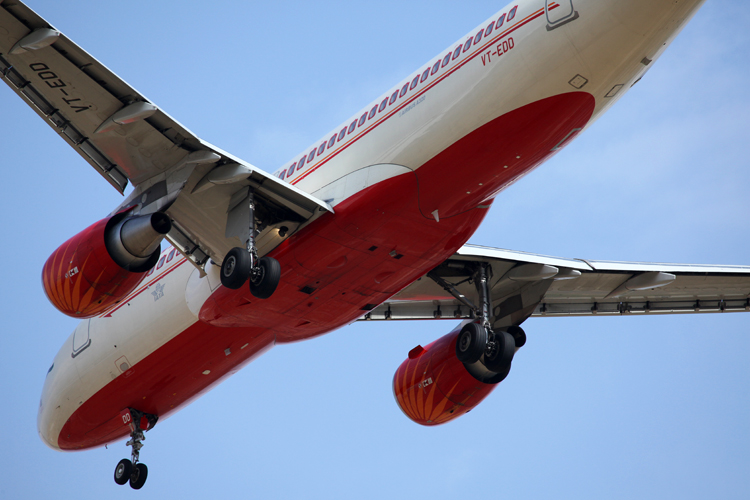- Prime Minister Narendra Modi inaugurates Aero India 2023 in Bengaluru; Releases Commemorative Stamp
- Defence Secretary meets delegations from Saudi Arabia, USA and Oman on the sidelines of Aero India 2023
- Foreign Ministers of 32 countries to attend Aero India 2023
- Embraer showcases the C-390 Millennium at Aero India 2023
Amidst calls for privatisation, Air India flies to record-breaking full capacity
Market gives a thumbs up to the beleaguered National Carrier amidst a fresh disinvestment bid

Even as its top management resumed making a case for privatising the Government-owned Air India, assailing its public sector culture as an anachronism in the contemporary market reality, the beleaguered Indian carrier has ironically logged a 99 per cent load factor for six days in May across domestic and international routes.

disinvestment mantra
In fact, its subsidiary, Air India Express recorded a stunning 100 per cent occupancy rate on all international flights to Indian destinations on May 31. Not a single seat was left unsold. This was a first.
"Air India Express thanks its esteemed passengers for their loyal support and for continuing to make it their airline of choice," said an ecstatic Dhananjay Kumar, the airline's spokesperson. "The airline's overall performance in May was commendable as it scored a double hat trick with a 99 per cent load factor on six days of May," the spokesperson added.
This makes it apparent that even though the National Carrier has sunk into a debt abyss, the market environment is sound and customer support robust.
Air India Express recorded a stunning 100 per cent occupancy rate on all international flights to Indian destinations on May 31. Not a single seat was left unsold. This was a first
Earlier this week, Ashwani Lohani, who's serving his second term as Air India's Chairman and Managing Director, virtually wrote the epitaph of Air India as a public sector company. In a signed article in a leading national daily, he wrote with candour remarkable for an appointee of the Government of India, suggesting that the only route to Air India's survival was through disinvestment and privatisation.
"Yet along the way, the organisation did stray and piled up a mountain of debt. Simultaneously, neither its growth nor administrative processes kept pace with the changing requirements of the 21st century," he observed.
Last year, the Government made an unsuccessful attempt to sell the airline after an effort to mitigate its spiraling debt of about 55,000 Crore ($7.9 Billion). Of this debt, a 29,464 Crore ($4.2 Billion) liability was transferred to a special purpose vehicle (SPV), which was in turn meant to get rid of this liability by selling profit-making subsidiaries of the airline. But there were still no buyers for Air India.
"The airline's overall performance in May was commendable as it scored a double hat trick with a 99 per cent load factor on six days of May," the spokesperson added
Struggling to pay off even the interest on the massive debt stockpile, Air India was further hit by Pakistan's 3-month airspace closure following India's cross-border air strike on a terrorist camp at Balakot inside Pakistan. It bled by an additional 550 Crore (about $80 Million) on account of flight diversions.
Having failed in the first go, the Government is now making a second attempt at finding a buyer. It has presented a preliminary information memorandum (PIM), inviting expressions of interest (EoI) by the first week of July. It is prepared to give 100 per cent stake to prospective buyers. There's also a promise for transfer of more debt to the SPV in order to sweeten the deal.
Having failed in the first go, the Government is now making a second attempt at finding a buyer. It has presented a preliminary information memorandum (PIM), inviting expressions of interest (EoI) by the first week of July. It is prepared to give 100 per cent stake to prospective buyers. There's also a promise for transfer of more debt to the SPV in order to sweeten the deal
But the plan to sell off profit making subsidiaries has drawn flak. Without these auxiliaries, Air India would be further enfeebled, detractors argue. For instance, Air India Express, has been a sweet spot for the airline since its launch as a low-cost carrier in 2005. With its cost-efficient business model, it has flown 4.3 million passengers each year on an average. Its network extends to 33 destinations out of which 13 are international and 20 domestic. The airline's fleet consists of 25 Boeing 737 - 800 NGs, which support its business model for providing the most economical air travel option to Indians to fly to the Middle-East and South-East Asian destinations.





